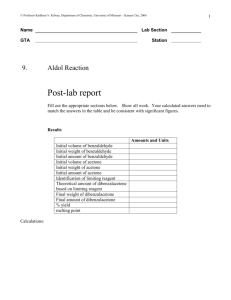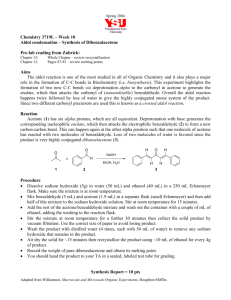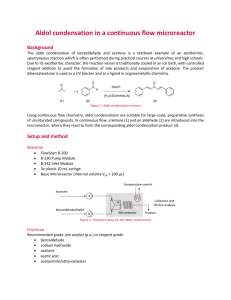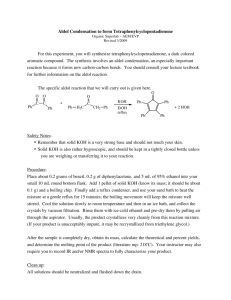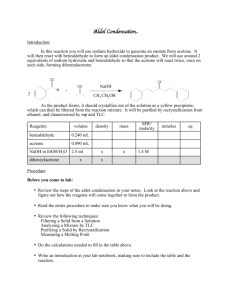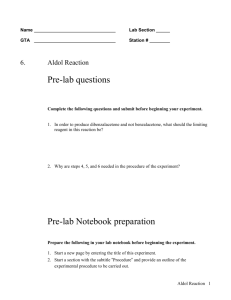advertisement
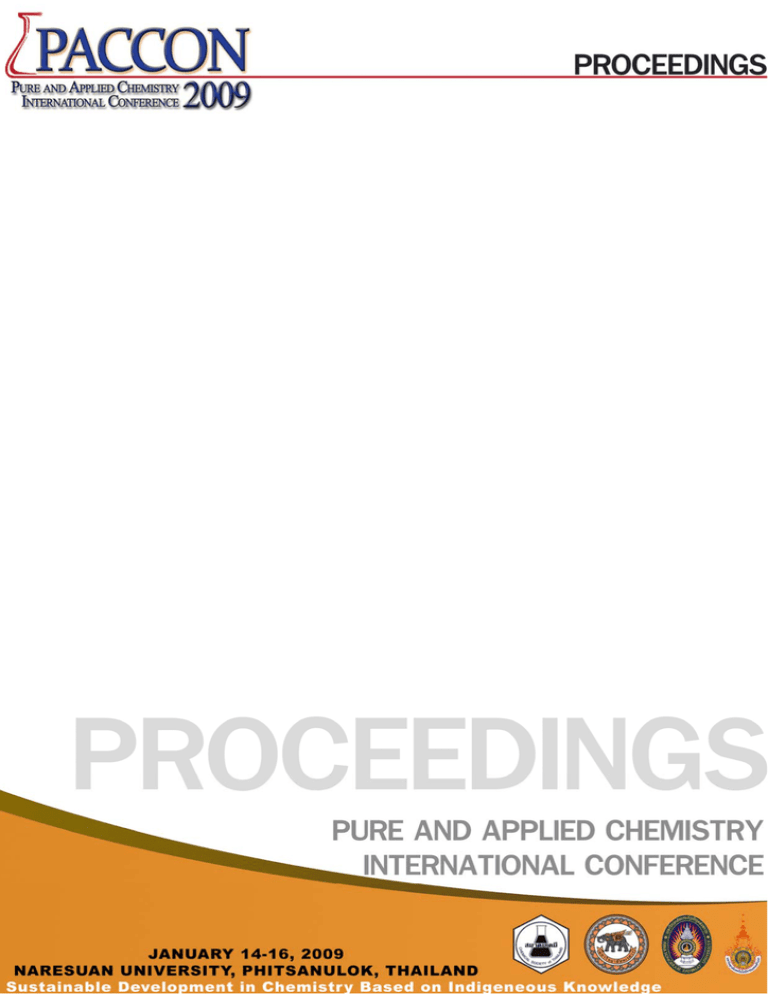
Edited with the trial version of Foxit Advanced PDF Editor To remove this notice, visit: www.foxitsoftware.com/shopping THE STUDY OF CROSSED ALDOL CONDENSATION AT THE SYNTHESIS OF ASYMMETRIC DIBENZALACETONE Sri Handayani*, Indyah Sulistyo Arty and Retno Arianingrum Department of Chemical Education, Faculty of Mathematics and Natural Sciences, State University of Yogyakarta, Karangmalang, Depok, Yogyakarta 55281, Indonesia *Email: handayani137uny@yahoo.com Abstract: The synthesis of asymmetric dibenzalacetone has been done by crossed aldol condensation. It can be made from 3,4-dimethoxybenzaldehyde, benzaldehyde and acetone as the starting materials. As a nucleophile, acetone, has α-hydrogens in two side. So, it can attack two kinds of aldehydes. The product will be characterized by 1H-NMR, 13C-NMR, HMQC and HMBC spectrometer. Therefore, it was identified as 1(E),4(E)-1-phenyl-5-(3’,4’-dimethoxyphenyl)-penta-1,4diene-3-one. Introduction Aldol Condensation is occured by a nucleophilic addition of the enolate ion to a carbonyl. Acetone also undergoes aldol condensation, but the equilibrium concentration of the product is generally small. Cross aldol condensation between p-annisaldehyde from fennel oil with acetophenone produce 2-hydroxy-4methoxychalcone [1]. The influence of the base concentration and reaction time on the cross aldol condensation reaction also has been reported [2]. Alnustone or 4(E),6(E)-1,7-diphenyl-4,6-heptadiene-3one is an asymmetric compound that isolated from Curcuma xanthorrhiza (Zingiberaceae). This compound was synthesized by Goksu, et al. using crossed aldol condensation between benzaldehyde and acetone, followed by reaction with cinnamaldehyde [3]. Handayani and Arty have synthesized 1.5diphenyl-penta-1,4-diene-3-one and its derivatives known as symmetrical dibenzalacetone. It made by crossed aldol condensation between acetone : benzaldehyde by 1:2 mol ratio. It also tested as a radical hydroxyl scavengers [4]. Asymmetric crossed aldol condensation have been done with various catalyst [5,6,7]. Tutik D had synthesized of a symmetrical dibenzalacetone that have a similar structure with the cinnamic acid derivatives[8]. From its structure, it is estimated that benzalacetone and dibenzalacetone will absorb ultraviolet in the same range. Thus, asymmetric dibenzalacetone will act as a radical scavenger and also a sun screen. In this research asymmetric dibenzalacetone, compound 5 namely 1(E),4(E)-1-phenyl-5-(3',4'-dimethoxyphenyl)penta-1,4-diene-3-one will be synthesized. This compound was made by crossed aldol condensation between acetone with two aldehydes which are the benzaldehyde and 3.4-dimethoxybenzaldehyde. Materials and Methods General . All materials were from Merck, among other acetone, benzaldehyde, 3.4dimethoxybenzaldehyde, ethanol, chloroform, hexane, and ethyl acetate. TLC was carried out using 0.25-mm plate Silica gel Merck 60 F254, column chromatography were performed by Silica gel 60 (230400 mesh). The 1H-NMR, 13C-NMR, HMQC and HMBC spectra were recorded on 500 MHz Jeol instrument. IR spectra were conducted using a Shimadzu 8300 FTIR spectrometer. 1(E),4(E)-1-phenyl-5-(3’,4’-dimethoxyphenyl)penta-1,4-diene-3-one (5). Into a solution of NaOH (0.025 mol, 1g) in aqueous ethanol (1:1) that was prepared at ambient temperature, benzaldehyde (0.01 mol, 1.06 g), acetone (0.01 mol, 0.58 g) and 3,4dimethoxybenzaldehyde (0.01 mol, 1.66 g) were added drop wise alternately. After additional stirring for 60 minutes, water (20 ml) was added to the reaction mixture which was then filtered. The extract was washed with water (20 ml x 3) and separated by column chromatography (d 2.5 cm, h 50 cm), with silica gel 60 (230-400 mesh) as the stationary phase and ethylacetate-hexane by 1:9 as the eluent. Four fractions were obtained from the column chromatography. The target compound was identified using thin layer chromatography with chloroformhexane 4: 6. Results and Discussion Improved Synthesis of 1(E),4(E)-1-phenyl-5(3’,4’-dimethoxyphenyl)-penta-1,4-diene-3-one (5). The preparation of compound 5 was initiated by the mixing of 1, 2 and 4 to give 5 ((Figure 1). The product of crossed aldol condensation between benzaldehyde, 3,4-dimethoxybenzaldehyde and acetone is a mixture of 4 compounds. There was separated by Column Chromatography (EtOAc-hexane, 1:9) to provide the asymmetric dibenzalacetone 5 (15.53%) as pale yellow oil. The multiple bond correlation of HMBC supported the structure (Table 1, Figure 2). In the 1H-NMR spectrum (500 MHz, CDCl3), three protons singlet and three protons double dublet were observed. The singlet at δ = 7.37 was assignable to H2’, 3.8 to H3’ and 3.9 to H4’. The double dublet at δ = 7.2; 7.63; and 6.9 was 388 PACCON2009 (Pure and Applied Chemistry International Conference) Edited with the trial version of Foxit Advanced PDF Editor To remove this notice, visit: www.foxitsoftware.com/shopping assignable to H3”, H4” and H5” respectively. Two equivalence methoxy signals at δ 3.8 and 3.9 were assigned to C3’ and C4’. Support spectra data provided by the IR (KBr), which indicates the existence of C=O (1645cm-1), aromatic C=C (15141417 cm-1) and CO ether (1255-1139 cm-1). Therefore, the structure of 5 was 1(E),4(E)-1-phenyl-5-(3’,4’dimethoxyphenyl)-penta-1,4-diene-3-one. H OMe 3" H 2" H H 4' 4" H 1" 5" 5 6" H H CH3CCH3 2 4 3 5' 6' H H H O Figure 2. The HMBC of compound 5 CH3 CHO 1 1' H 1 2 O OMe 3' 2' 3 OMe O Conclusions 1(E),4(E)-1-phenyl-5-(3’,4’-dimethoxyphenyl)-penta1,4-diene-3-one can be made from acetone, benzaldehyde and 3,4-dimethoxybenzaldehyde by crossed aldol condensation. OMe OHC 4 OMe OMe Acknowledgement This experiment was sponsored by Hibah Bersaing Project, Ditjen Dikti RI. References O 5 Figure 1. Synthesis of 1(E),4(E)-1-phenyl-5-(3’,4’dimethoxyphenyl)-penta-1,4-diene-3-one. Table 1. (CDCl3) 1 H and 13 C-NMR data of compound 5 C no. δH (∑H; m; J Hz) ppm 1 2 3 4 5 1’ 2’ 3’ 3’-OMe 4’ 4’-OMe 5’ 6’ 1’’ 2’’ 3’’ 4’’ 5’’ 6’’ 7.7 (1H; d; 16) 6.95 (1H; d; 15) 7.1 (1H; d; 16.5) 7.4 (1H; d; 12.5) 7.37 (1H; s ) 3.8; (3H, s) 3.9 (3H; s) 6.85 (1H; d; 7) 7.33 (1H; d; 3) 7.14 (1H; d; 2) 7.2 (1H; dd; 7.5) 7.63 (1H; dd; 7.5) 6.9 (1H; dd; 10) 7.06 (1H; d; 3.5) δC ppm 143 124 189 125 129 135 145 148 56 149 56 111 129 151 110 123 128 120 110 HMBC (500 MHz) C6’’, C2,C3 C3 C3, C5,C4’ C1’ C5 C4’ C3’ C4’, C1’ C1’, C5 C1’’, C6’’, C1 C2’’, C1’’ C4’’ C4’’, C1’’, C1 [1]Handayani, S., Sintesis 4’-metoksiflavanon Menggunakan o-hidroksiasetofenon dan p-anisaldehida dari minyak Adas, Master's Thesis, Gadjah Mada University, 2000. [2] Handayani, S., Sunarto and Kristianingrum, S., Optimization of time reaction and hydroxide ion concentration on flavonoid synthesis from benzaldehyde and its derivatives, Indonesian journal of Chemistry Vol 5 No.2 Juli 2005 Indonesian Journal of Chemistry, 5, No.2 (2005), pp 88-93. [3] Goksu, S., Celik, H. and Secen, H., Turk. J. Chem. 27 (2003), pp 31-34. [4] Handayani, S. and Arty, I.S., Synthesis Of Hydroxil Radical Scavenger From Benzalacetone And Its Derivatives, 2nd USM Penang International Postgraduate Convention, Proc. Penang, Malaysia, 2008 [5] Yamano, Y., Fujita, Y., Mizuguchi, Y., Nakagawa, K., Okano, T., Ito, M. And Wada, A., Chem. Pharm. Bull., 55(9) (2007), pp 1365-1370. [6] Mlynarski, J., European Journal of Organic Chemistry, 21 (2006), pp 4779-4786. [7] M.Manuel B. Marques, Asymmetric Cross-Aldol Reaction of Aldehides : A Formidable Synthetic Chalengge, Requimte-FCT-New University of Lisbon (2005). [8] Tutik, D., Oksidasi Anetol dan Kajian Pengaruh Gugus Metoksi Turunan benzaldehide Terhadap Reaksi Kondensasi Benzoin dan Aldol Silang, Master Thesis, Gadjah Mada University, 1996. 389 PACCON2009 (Pure and Applied Chemistry International Conference)

